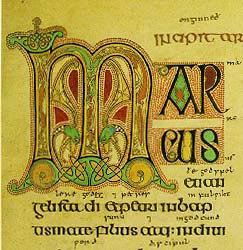History of Illumination
Until the beginning of the thirteenth century, most of the scribes and
illuminators were religious men called monks. The books they copied were
religious works, to be used in missionary work. The decorated pages made it easy
for missionaries to find the beginning of a particular section. The pictures
depicted the events described in the text. Often the illustrations were designed
so that they could be seen from a distance when held up in front of an audience.
People believed that books--especially illuminated books--represented wealth and
power, including magical powers. For example, many believed that medicine made
from water in which a holy book had been soaked would cure sicknesses. People
also feared that they would suffer great pain if they damaged a book. Except for
missionaries, the only people who could afford to own books in the first part of
the Middle Ages were the ruling class: feudal lords, kings and emperors.
Beginning in the early 1200s, as the wealthy merchant class grew, more people
wanted and could afford books of their own. To satisfy the increased demand,
professional scribes and illuminators who were not monks began to work.
Styles of Illumination
Celtic

The Celtic style of illumination was used in the early centuries of the Middle
Ages. The decorations were usually made with bright colors, and often had birds
and animals intertwined in spiral designs. Illuminators who used the Celtic style
often painted small red dots around the decorated letters, a process called
"rubrication." Rubrication was done to create a shadow effect, so that the
letters seemed to be lifted above the page. The word, "miniature," meaning a
small painting in an illuminated manuscript, comes from the word, "minim," which
was the red lead used for rubrication. The example above is from the Lindisfarne Gospels,
which was created in the late 7th century. Notice the red dots around the letters.
  
|

